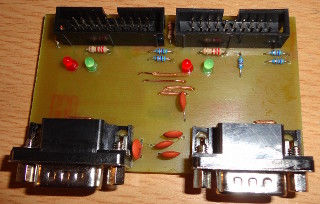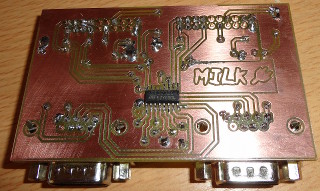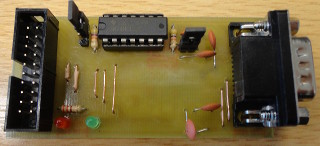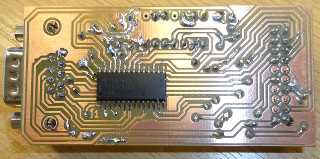|
RS-232 is the most common serial communications protocol.
Even when the norm stablishes bipolar signaling, in practice the unipolar implementations are
also named RS-232. It was originally designed for long range communications using modems, but nowadays is commonly used for short direct communications. These different scenarios impose a variety of situations, and hence we need various plug-ins.
RS-232 basic:This plug-in is used when we use logic levels for signaling (unipolar). It asumes that we don't use hardware handshake, and hence we don't use the modem signals (RTS, CTS, etc.), or they can be dummy (null-modem). Thanks to these limitations this plug-in is just some wires and a couple of connectors, and we don't need electronic devices. The most common application is the communication with a microcontroller. The following schematic depicts four possible cases, using DB-9 or DB-25, and with or without null-modem: Schematic. RS-232 simple:This plug-in is used when we use logic levels for signaling (unipolar). It asumes that we use hardware handshake, and hence we use the modem signals (RTS, CTS, etc.). Thanks to these limitations this plug-in is just some wires and a couple of connectors, and we don't need electronic devices. The most common application is the communication with a microcontroller. The following schematic uses a DB-9 connector: Schematic. RS-232 basic buffered:This plug-in is used when we use the signaling specified by the RS-232 norm (bipolar). It asumes that we don't use hardware handshake, and hence we don't use the modem signals (RTS, CTS, etc.), or they can be dummy (null-modem). As we need to generate, and tolerate, bipolar voltages this plug-in needs an electronic device. The proposed implementation uses an SP3232ECN (SOIC-16 package). As we don't need hardware handshake a single chip can implement two RS-232 channels in one plug-in. For this plug-in we used DB-9 connectors, an adaptor is needed if you use DB-25. The circuit was implemented using KiCad. You can download the KiCad Files, the Schematic (PDF) and the Gerber Files.
RS-232 full buffered:This plug-in is used when we use the signaling specified by the RS-232 norm (bipolar). It asumes that we use hardware handshake, and hence we use the modem signals (RTS, CTS, etc.). As we need to generate, and tolerate, bipolar voltages this plug-in needs an electronic device. The proposed implementation uses a MAX3243E (SOIC-28 wide package). Additionally, it implements the Suspend mode and wake-up when we have an incoming call. For this plug-in we used DB-9 connectors, an adaptor is needed if you use DB-25. The circuit was implemented using KiCad. You can download the KiCad Files, the Schematic (PDF) and the Gerber Files.
|
|||||||||||||||||










